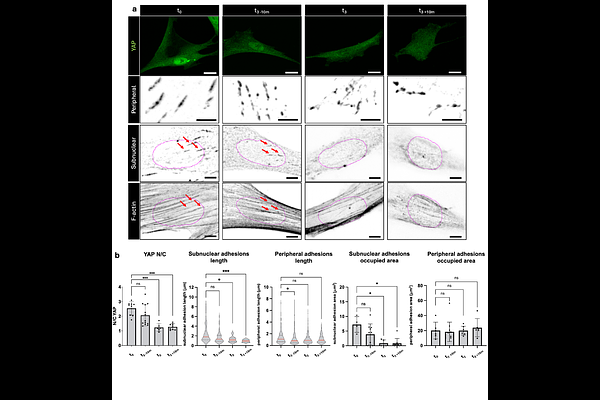YAP/TAZ mechanotransduction is a fast cellular response to subnuclear adhesions revealed by mechanically dynamic substrates

YAP/TAZ mechanotransduction is a fast cellular response to subnuclear adhesions revealed by mechanically dynamic substrates
Gandin, A.; Torresan, V.; Pelosin, M.; Vanni, G.; Busetto, R.; Citron, A.; Suli, A.; Panciera, T.; Zanconato, F.; Piccolo, S.; Brusatin, G.
AbstractMechanotransduction, the conversion of mechanical cues into biochemical signals, is a cardinal regulator of myriad cell behaviors. However, the precise timing by which mechanical signals are sensed and relayed to the nucleus remains poorly understood. To address this gap, we developed dynamically degradable polyacrylamide (DPAA) hydrogels that allow in situ modulation of substrate stiffness while maintaining continuous cell adhesion, thereby mimicking physiological mechanical transitions. Using these tools, we discovered that YAP/TAZ, key mechanosensitive transcription factors, respond rapidly to changes in substrate stiffness primarily through changes in subnuclear adhesions. As substrate softening reaches the low kPa threshold (<2kPa), subnuclear adhesions and their associated ventral actin fibers disassemble within minutes, concurrently causing cytoplasmic relocalization of YAP/TAZ. In cells experiencing such a continuum of mechanical states, peripheral focal adhesions remained surprisingly stable while undergoing continuous remodeling, suggesting a more resilient and adaptable mechanism of force transmission than previously modeled. Our time-resolved results indicate that subnuclear adhesions act as rapid mechanotransduction nodes, leading to YAP/TAZ-mediated nuclear responses independently of peripheral adhesion dynamics. This enhanced understanding of YAP/TAZ regulation should advance the field of mechanobiology and offers potential insights for manipulating cellular responses in regenerative medicine and cancer therapy.